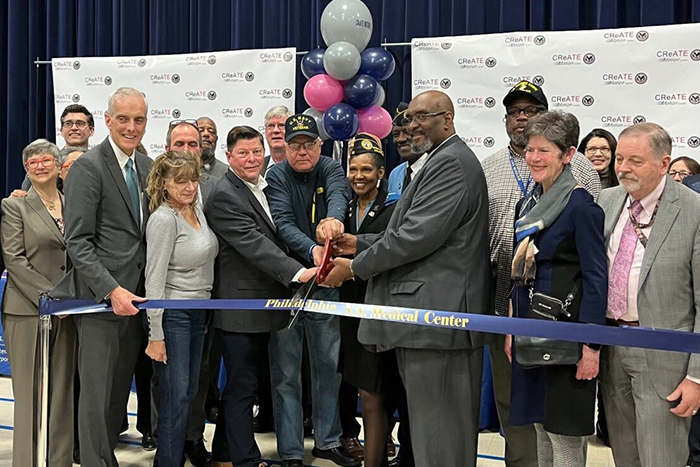Office of Research & Development |
 |


VA Secretary Denis McDonough, VA researchers, and local Veterans gather to celebrate the opening of the new CReATE Motion Research Center at the Philadelphia VA Medical Center on March 27.
April 1, 2024
By Erica Sprey
VA Research Communications
"We can never do all that we should, but with the help of our academic partners and VA researchers, we can strive to serve Veterans as well as they served us."
The Department of Veterans Affairs opened the Cartilage Regeneration Using Advanced Technologies to Enable (CReATE) Motion Research Center at the Michael J. Crescenz VA Medical Center in Philadelphia, March 27, to discover new treatments and therapies for Veterans and others who suffer from osteoarthritis and related conditions.
The Honorable Denis McDonough, Secretary of Veterans Affairs, gave opening remarks at the ribbon-cutting ceremony. The VA Secretary also introduced Master Sgt (Ret.) David Gillespie, who served in the 82nd Airborne Division and has had multiple knee replacement surgeries for osteoarthritis.
“We can never do all that we should, but—with the help of Congress, our Veteran Service Organizations, academic partners, and VA researchers—we can strive to serve Veterans as well as they served us,” said McDonough. “With the opening of the new CReATE Motion Center, top researchers at the Philadelphia and Atlanta VA Medical Centers are conducting groundbreaking research that will help Veterans stay mobile while addressing this serious disease. They are developing stem cell therapies, new ways to grow cartilage, and state-of-the-art techniques to repair existing cartilage. Their efforts will mean more mobility, better flexibility, and fewer surgeries for our Veterans who have osteoarthritis.”
Dr. Robert Mauck, director of the CReATE Motion Center and co-director of the Translational Musculoskeletal Research Center at the Philadelphia VA, said the motivation to develop new technologies to treat osteoarthritis stems from a desire to help Veterans “get back on their feet.”
“Once a Veteran stops moving, there are many downstream effects that happen,” said Mauck. “Not only are they unable to engage from a physiological standpoint, but they are also limited from a psychosocial standpoint, which could lead to loneliness and social isolation.
“We want Veterans to continue to engage in their communities,” he added. “Our job, as I see it, is to be at the cutting-edge of what’s happening in this field and bring it to Veterans as quickly as possible.”
“It is my hope that one day we will have multiple treatment options to improve the lives of our Veteran patients with osteoarthritis, just as we do today for patients with other less common forms of arthritis,” said Dr. Carla Scanzello, associate director of the CReATE Motion Center.
The CReATE Motion Center was designed to treat multiple stages of arthritis: stopping disease progression in the early stages, retaining ‘good’ cartilage in the mid-stages of the disease, and ultimately replacing cartilage in Veterans with late-stage arthritis.
The center will bring together investigators from the Philadelphia VA, the Atlanta VA Medical Center, the University of Pennsylvania, and Emory University. The research team will include scientists with expertise in bioengineering, cell-based therapies, regenerative medicine, pain management, rheumatology, neurology, and orthopedic surgery, among others. Furthermore, the VA Office of Research and Development has committed $6.3 million dollars over five years to help fund the CReATE Motion Center.
The center will be organized into three research cores that are designed to accelerate discovery and implementation of new technologies.
More than 32.5 million U.S. adults live with osteoarthritis, according to the CDC, and one in three Veterans are affected. Osteoarthritis is a complex disease that attacks the cartilage and supporting tissues within joints like the hips and knees, causing pain and disability. The disease can be caused by traumatic injury to the joints but can also result from inflammation within the body.
There is no cure for osteoarthritis. Physicians currently have limited treatment options—they can prescribe pain medications, physical therapy, or total joint replacements. However, none of these are good options for younger Veterans or others who want to lead more active lives.
“I think we need to acknowledge how complex osteoarthritis is as a disease,” said Dr. Hicham Drissi, CReATE site director at the Atlanta VA Medical Center. “Consequently, we need to adapt therapeutic solutions based on the stage of disease. For our younger Veterans in early-stage disease, we want to preserve their joints and delay or avoid surgery. For Veterans with age-related disease, we need to develop regenerative solutions to maximize treatment outcomes. The CReATE center will enable us to develop different therapeutic solutions for every stage of the disease.”
VA Research Currents archives || Sign up for VA Research updates